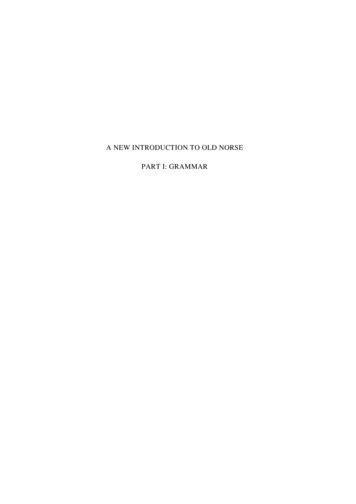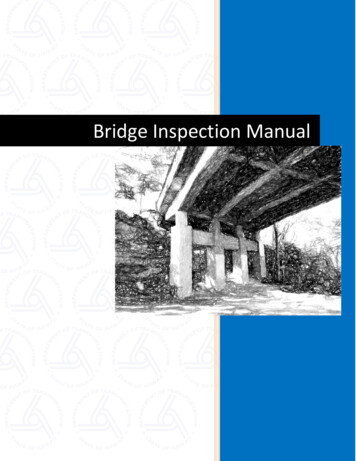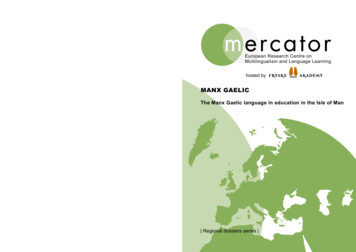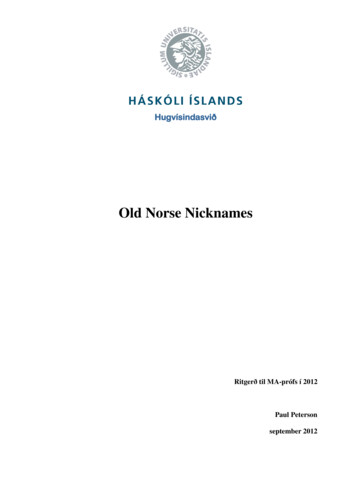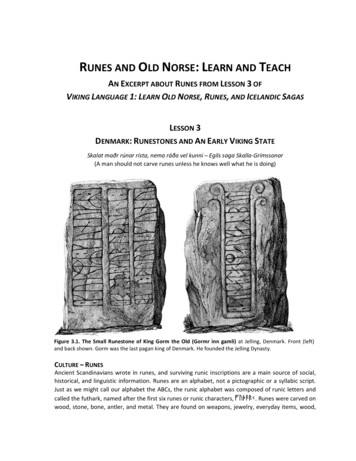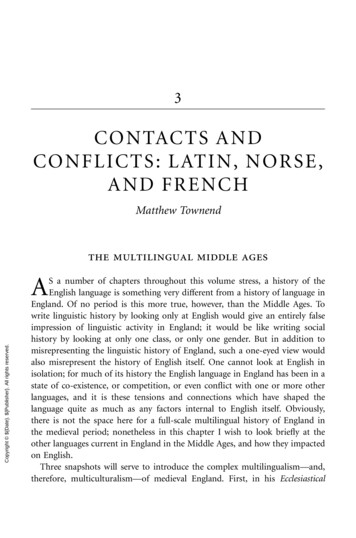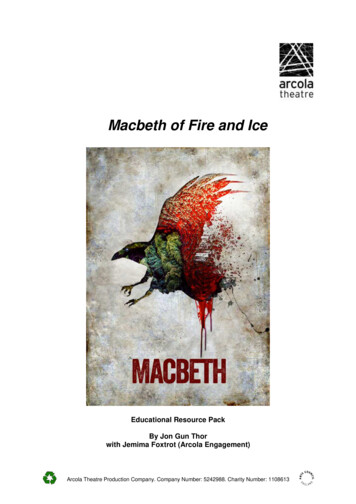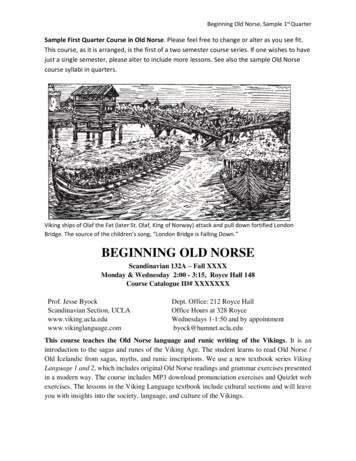
Transcription
Beginning Old Norse, Sample 1st QuarterSample First Quarter Course in Old Norse. Please feel free to change or alter as you see fit.This course, as it is arranged, is the first of a two semester course series. If one wishes to havejust a single semester, please alter to include more lessons. See also the sample Old Norsecourse syllabi in quarters.Viking ships of Olaf the Fat (later St. Olaf, King of Norway) attack and pull down fortified LondonBridge. The source of the children’s song, “London Bridge is Falling Down.”BEGINNING OLD NORSEScandinavian 132A – Fall XXXXMonday & Wednesday 2:00 - 3:15, Royce Hall 148Course Catalogue ID# XXXXXXXProf. Jesse ByockScandinavian Section, UCLAwww.viking.ucla.eduwww.vikinglanguage.comDept. Office: 212 Royce HallOffice Hours at 328 RoyceWednesdays 1-1:50 and by appointmentbyock@humnet.ucla.eduThis course teaches the Old Norse language and runic writing of the Vikings. It is anintroduction to the sagas and runes of the Viking Age. The student learns to read Old Norse /Old Icelandic from sagas, myths, and runic inscriptions. We use a new textbook series VikingLanguage 1 and 2, which includes original Old Norse readings and grammar exercises presentedin a modern way. The course includes MP3 download pronunciation exercises and Quizlet webexercises. The lessons in the Viking Language textbook include cultural sections and will leaveyou with insights into the society, language, and culture of the Vikings.
Icelandic sagas and the mythology of the Old Norse gods are one of the world’s great literatures.We read short and long passages that take you deep into the world of the Vikings and OldScandinavia. These Norse texts teach us much about life in the Western Medieval World.The course has no prerequisites, and the student needs no previous knowledge of otherlanguages. Old Norse is taught in a way that prepares the student to learn Modern Icelandic. Thiscourse, Scandinavian 132A, serves as an entry level course for more advanced study of Vikingliterature, history, mythology, archaeology, language, and society.Grading:Based primarily on class preparation, grammar homework, cumulative quizzes, andvocabulary quizes:15% Translation preparation and vocabulary15% Grammar homework60% Quizes10% ParticipationRequired Texts: Byock, Jesse. Viking Language 1: Learn Old Norse, Runes, and Icelandic Sagas.Jules William Press, 2013. Available on Amazon.com and in bookstores. Viking Language 1: Audio Lessons 1-8 (MP3 download)The two MP3 Audio Lesson albums (Lessons 1-8 and 9-15) are available for download onAmazon (under "all", "Music", and "Digital Music"), itunes, and www.cdbaby.com Viking Language learning modules on Quizlet (seehttps://quizlet.com/class/1806241/)Readings and Homework (HW) are due on the appointed day (meeting) as noted on thesyllabus. Students should be prepared to translate in class the reading passages in theassigned lessons. The lessons of Viking Language 1 are coordinated with: Viking Language Audio Files. Use the respective audio file each time you begina new reading passage. The audio files teach both pronunciation and vocabulary.2
Beginning Old Norse, Sample 1st Quarter Viking Language learning modules on Quizlet(https://quizlet.com/class/1806241/). For each meeting, study the vocabulary liston Quizlet. The Viking Language Quizlet lessons are prepared by Prof. LeeForester working with the Viking Language Old Norse Project. The Quizletvocabulary lists concentrate on teaching the 246 most frequent „saga words“taught in the Viking Language lessons. We suggest starting with Flashcards,followed by Speller, Learn, and Test. Have fun with the games.Schedule of Meetings:MEETINGS 1 & 2(dates, week 1)MEETINGS 3 & 4(dates, week 2)MEETINGS 5 & 6(dates, week 3)MEETINGS 7 & 8(dates, week 4)MEETINGS 9 & 10(dates, week 5)Meeting 1. Introduction to Old Norse.Readings: Introduction to Viking Language 1: Learn Old Norse,Runes, and Icelandic Sagas, pp. 19-38 (About Vikings, IcelandicSources, and Scandinavian Runes)Meeting 2. Lesson 1: Sailing West.Readings: Lesson 1, including ON Passages, GrammarExplanations, and Exercises.Homework: Audio Lessons tracks 1-3; Quizlet Vocabulary List1Meeting 3. Lesson 2: Norse Settlers in Greenland andVinland.Readings: Lesson 2.1-2.14Homework: Audio Lessons track 4: Quizlet Vocabulary List 2Meeting 4.Homework: 2.15-2.22. Prepare for short Quiz 1 on lessons 1-2.Meeting 5. Lesson 3: Denmark: Runes and the First VikingState.In class, Quiz 1 on lessons 1-2.Readings: 3.1-3.13Homework: Audio Lessons tracks 5-8; Quizlet Vocabulary List3Meeting 6.Readings and Exercises: 3.14-3.26Meeting 7. Lesson 4: Kings and Heroes.Readings: 4.1-4.16Homework: Audio Lessons tracks 9-11; Quizlet Vocabulary List4Meeting 8.Readings and Exercises: 4.17-4.27Meeting 9. Lesson 5: Sweden: A Family Runestone.Readings: 5.1-5.15Homework: Audio Lessons tracks 12-13; Quizlet VocabularyList 5Meeting 10. Reading Chapter 1Homework: Audio Lessons track 14
MEETINGS 11 & 12(dates, week 6)MEETINGS 13 & 14(dates, week 7)MEETINGS 15 & 16(dates, week 8)MEETINGS 17 & 18(dates, week 9)MEETINGS 19 & 20Dates, week 10Readings and Exercises: 5.16-5.30Meeting 11. Lesson 6: Sacral Kingship in AncientScandinavia.Readings: 6.1-6.10Homework: Audio Lessons track 15; Quizlet Vocabulary List 6QUIZ 2: lessons 1-5Meeting 12. Reading Chapter 2Readings and exercises: 6.11-6.25Homework: Audio Lessons track 16Meeting 13. Lesson 7: Norway‘s Harald Fairhair and HisSon Eirik Bloodaxe.Readings: 7.1-7.11Homework: Audio Lessons tracks 17 and 18; QuizletVocabulary List 7Meeting 14.Readings: 7.12-7.25Homework: Audio Lessons track 19Meeting 15. Lesson 8: Harald Hardradi in Constantinople.Readings: 8.1-8.11Homework: Audio Lessons track 20; Quizlet Vocabulary List 8QUIZ 3: lessons 3-7Meeting 16.Readings: 8.12-8.26Homework: Audio Lessons tracks 21 and 23Meeting 17. Lesson 9: Raiding in the WestReadings: 9.1-9.13Homework: Audio Lessons tracks 9.1, 9.12, and 9.25a & 9.25b(download Viking Language MP3 album #2, lessons 9-15 or theindividual audio passages for lesson 9.Quizlet Vocabulary List 9Meeting 18.Readings: 9.14-9.25Audio Lessons, tracks 9.25a and 9.25bHomework: Begin Review of Lessons 6-9Meeting 19. Review Lessons 1-9Meeting 20. Quiz 4: Lessons 6-9Homework: review for final quiz4
Beginning Old Norse, Sample 1st QuarterAlong with the Icelandic Sagas and the language of the Viking Age, this course teachesrunes. The sagas tell us: A person should not carve runes, unless he well knows how to control them(„Skalat maðr rúnar rísta, nema ráða vel kunni“).Figure Error! No text of specified style in document.1 The Runestone, front and back, of KingGorm the Old (Gormr inn gamli) at Jelling, Denmark. Gorm was the last pagan king of Denmark.He founded the Jelling Dynasty.Ancient Scandinavians wrote in runes, and surviving runic inscriptions are a main source ofsocial, historical, and linguistic information about the language and culture of the Viking Age.Runes are an alphabet, not a pictographic or a syllabic script. Just as we might call our alphabetthe ABCs, the runic alphabet was composed of runic letters. It was called the futhark, namedafter the first six runes or runic characters. Runes were carved on wood, stone, bone, antler, andmetal. They are found on weapons, jewelry, everyday items, and on surviving pieces of woodand bark. Runes were used for identification, commemoration, messages, and magic. Runicinscriptions are the closest written sources to the speech of the Viking Age (From the textbook,Viking Language 1).
on Quizlet. The Viking Language Quizlet lessons are prepared by Prof. Lee Forester working with the Viking Language Old Norse Project. The Quizlet vocabulary lists concentrate on teaching the 246 most frequent „saga words“ taught in the Viking Language lessons. We suggest starting with Flashcards, followed by Speller, Learn, and Test.
